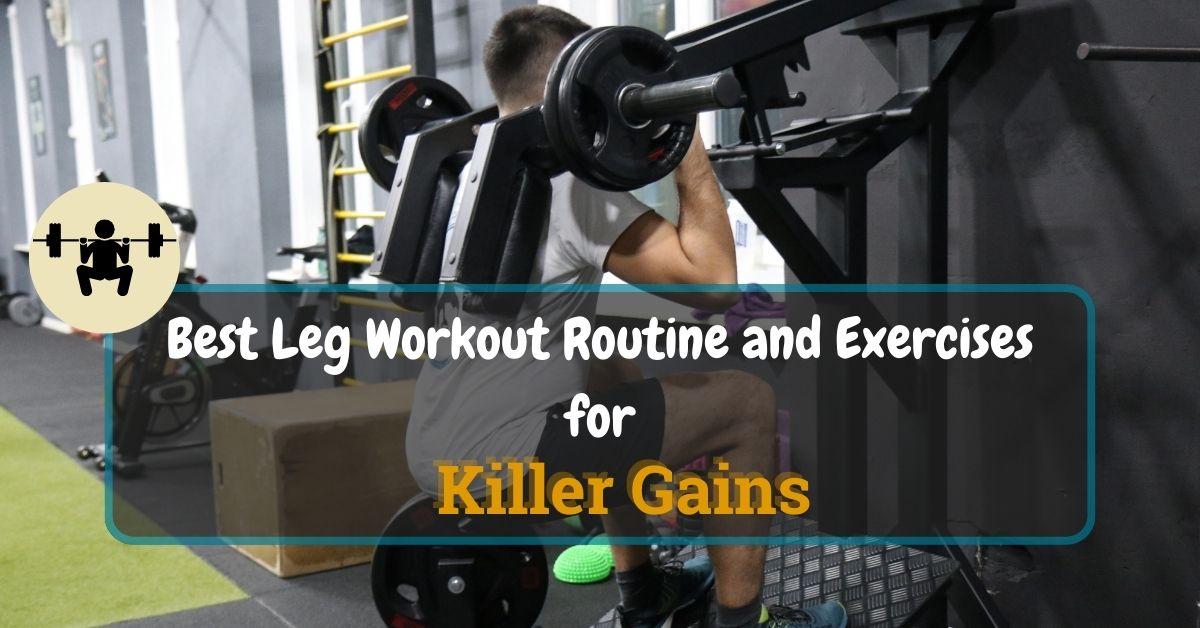If you plan to unlock powerful leg gains, you need to have some strategy or a leg workout routine that will help you with that. This complete guide reveals the best leg exercises to get yourself strong, toned leg muscles.
Table of Contents
ToggleI will dive into specific workouts catered to different needs but also cover some basics like lunges and squats. Incorporating some of these exercises will elevate your workout with the combination of isolation and compound movement exercises.
It does matter if you are a complete beginner or a seasoned gym enthusiast; you will find useful information below.
Start Building Your Dream Body Today
Ready to elevate your fitness game without falling into the trap of dull, repetitive routines that just don’t deliver? Imagine sculpting your ideal physique and boosting your health, all while still enjoying life’s pleasures, like those irresistible weekend getaways and your aunt’s legendary cheesecake. With our online fitness and nutrition coaching service, you don’t have to compromise. Dive into a personalized fitness journey that blends perfectly with your lifestyle, not against it. Book your completely free discovery consultation today, and take the first step towards a transformation that doesn’t require giving up the joys of life.

“I was skeptical about online fitness coaching, but Functional Body Savage completely changed my perspective. Vanja and Radomir’s personalized approach and attention to detail have helped me achieve goals I never thought possible. I’m stronger, more confident, and grateful for their guidance.”
Emily Thompson, San Francisco, CA
Learn More About Our Online Coaching ServiceQuick Summary
- The best leg workout routine includes exercises such as barbell squats, barbell Romanian deadlifts, Pendulum squats, Bulgarian split squats, single-leg glute bridges, and standing calf raises.
- Doing a proper warm-up will get your blood pumping and increase your heart rate.
- If you want to activate the muscle you plan to use in a workout, do simple exercises like lunges or bodyweight squats.
- Quads, hamstrings, abductors, calves, and glutes make up the legs.
Ultimate Leg Workout Routine: 6 Best Leg Exercises to Include
Here is the ultimate leg workout routine you must try to build functional strength and muscle hypertrophy.
1. Barbell Squats
Barbell squats are a compound leg exercise that is great if you want to work on your quadriceps, glutes, and hamstrings. With this fundamental exercise, not only will you build strong legs but also improve the stabilizer muscles and core muscles.
Nonetheless, incorporating barbell squats into your routine will help overall muscle development and is a key exercise in many training programs.

Steps:
- Put the barbell on a squat rack at chest height and step underneath, placing it on your upper back.
- Turn toes slightly out, and stand with feet shoulder-width apart.
- Keep your chest up and back straight while inhaling and bending your knees and hips simultaneously.
- Go lower until your thighs are parallel to the ground.
- Push through your heels and exhale, straighten your legs, and go back to the starting position.
- Make sure you control your movements throughout to keep up a proper form and balance.
Pro Tip: Start with lighter weights to perfect your form, keep your gaze forward, and engage the core for stability.
2. Barbell Romanian Deadlifts
A Romanian deadlift is one of the best exercises that target your glutes, hamstrings, and lower back. With the hinge movement, you should focus on hip extension, making it an exceptional exercise for your posterior chain muscles.
It puts less stress on your lower back in comparison to the usual deadlift movement, making it a great option for those who want to have a stronger posterior chain but with reduced stress on the lumbar spine.
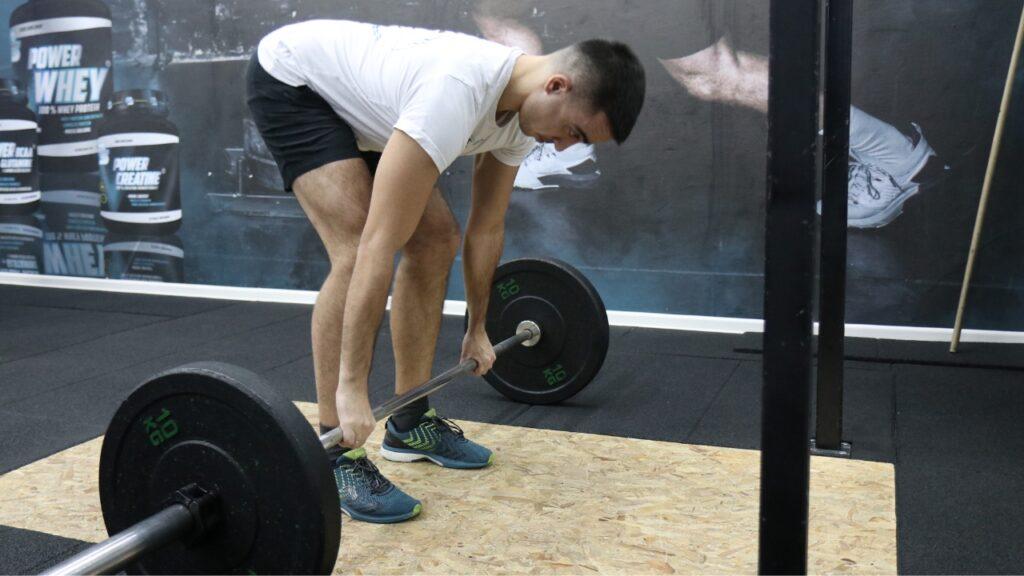
Steps:
- Hold a barbell in front of your thighs and start with a hip-width stance.
- Lower the barbell towards the ground, hinging your hips and maintaining a straight back.
- Go down until you feel a stretch in your hamstrings.
- Extend your hips forward to go back to the starting position
- To avoid risking any back injury, make sure you have a slight bend in the knees.
- Do the desired amount of reps while putting the main focus on the hip hinge movement.
Pro Tip: Put the barbell next to your body during the movement to ensure you get maximum hamstring activation.
3. Pendulum Squats / Leg Press
Pendulum squat is an exercise that is machine-based, providing you with lower back support, which is very useful if you are just starting, and allows you to place a foot with more versatility so you can target a different muscle group.
Adding pendulum squats into your workouts will improve leg strength while giving you a more stable and controlled environment for a leg workout.
Don’t have a pendulum/hack squat machine at your gym? No worries, just switch things up with landmine hack squats instead for nasty quad gains and healthier knees.
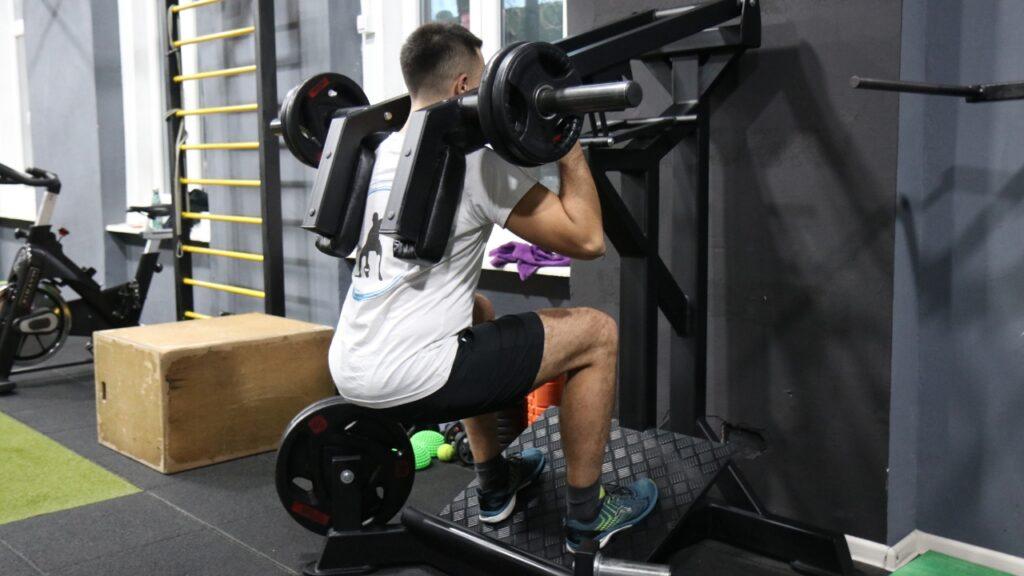
Steps:
- Adjust the machine so it fits you properly while making sure you have proper back support.
- Put your feet hip-width apart on the platform of a machine.
- Release the safety lock and lower the weight by bending your knees.
- Push through your heels to extend your legs, and after doing that, easily go back to the starting position.
- You can do several different variations of this exercise by having different foot positions to target various leg muscles.
- Do a controlled movement by avoiding getting your knees locked, and keep the tension strictly on your muscles.
Pro Tip: Adjust the machine so it fits you comfortably, make sure that your back is supported properly in that situation, and keep control throughout the whole movement.
4. Bulgarian Split Squats (Dumbbell or Barbell)
The Bulgarian split squat is a highly effective movement for isolating one leg and working on the hamstrings, glutes, and quadriceps. Also, this unilateral exercise helps with any sort of muscle imbalance and will enhance stability.
Using a barbell or dumbbell adds resistance, making it even more intense and promoting a symmetrical development in your lower body.
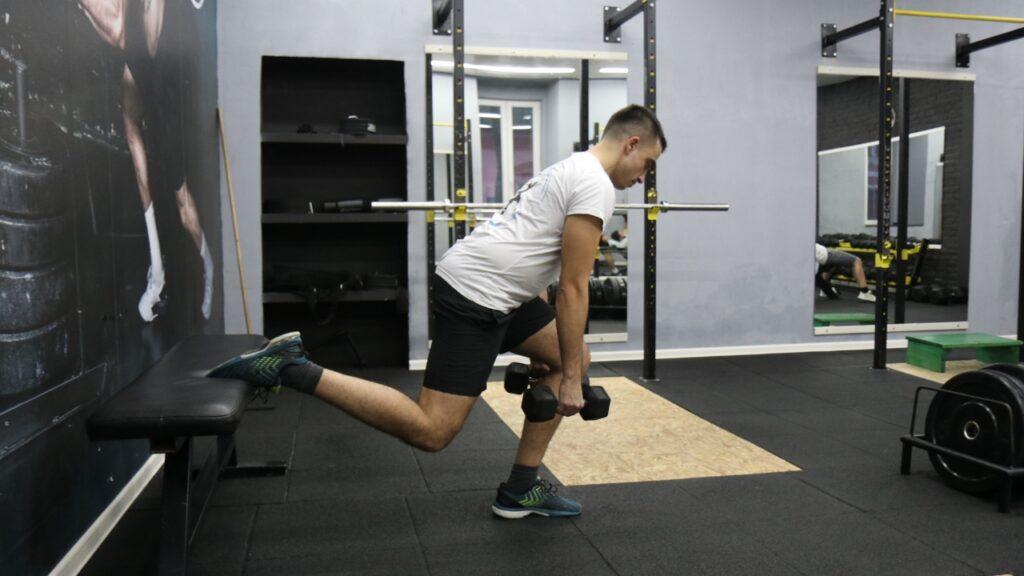
Steps:
- Assume a shoulder-width feet stance in front of a platform or a bench with a barbell on your back or with a dumbbell in each hand.
- Make sure that your front foot is at a comfortable distance away while placing the back foot behind on an elevated surface or bench.
- Descend by bending your front knee, lowering into the lunge, and forming a 90-angle with it.
- To go back to the starting position, use the strength from your front leg.
- For the best possible stability and balance, you need to engage your core muscles.
- Do the amount of reps with one leg before switching it to the other.
Pro Tip: If you want to master balance when doing this exercise, start first only with your body weight. After that, progressively add on more weights and keep an upright chest during the movement.
5. Single-Leg Glute Bridges
A single-leg glute bridge is an exercise that isolates the glute muscles and activates core muscles. Doing this movement will help you improve hip strength and stability while minimizing the chance of muscle imbalance between the right and left sides.
However, it is particularly important for the enchantment of glute activation and functional mobility.
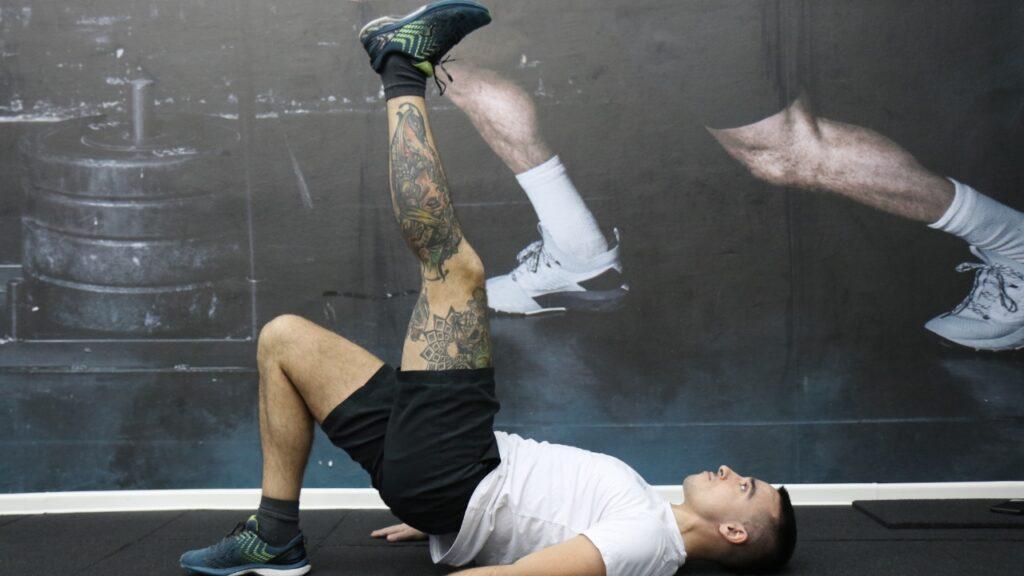
Steps:
- Lie on your back, bend one knee, and keep the other one extended.
- Lift your hips forward and push through the heel of the bent leg.
- When you are at the top of the movement, stop and squeeze your glutes.
- Put your hips back down to the floor.
- Do the desired amount of reps on one leg before switching it.
- To maximize the stability, make sure you keep your core engaged.
Pro Tip: Focus on the connection between your mind and muscles, emphasizing the contraction of your glutes while performing the movement.
6. Standing Calf Raises
Standing calf raise will target your calf muscles and help with the development of ankle stability. If you are a person who is involved in jumping and running activities, this exercise is highly recommended for you.
The incorporation of calf raises in your workout will contribute to a more rounded and well-developed lower body stability and strength.
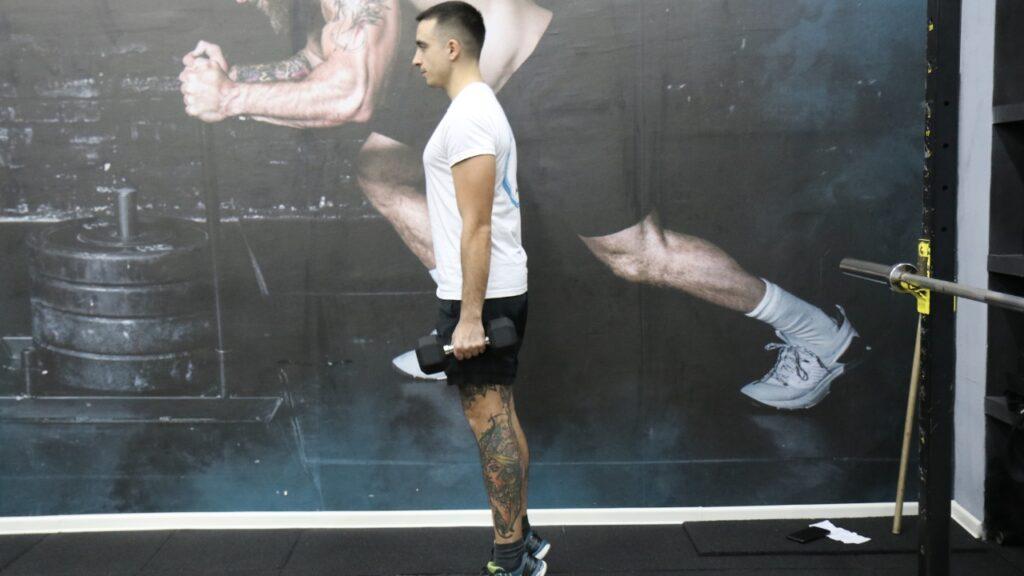
Steps:
- Stand with your feet hip-width apart on flat ground.
- Lift your heels as high as possible while pushing it through your feet.
- When you are at the top of the movement, hold for some time.
- Go lower with your heels, below the ground level.
- Rinse and repeat until you do the number of reps you want to do.
- If you want to get a maximum calf engagement, make sure you are using the full range of motion.
Pro Tip: For optimal effectiveness, try to keep a controlled and slow pace while gradually increasing the weight to challenge your calves.
9 Best Leg Workout Routine Variations Based on a Goal
Below, you may find the different leg workout routines based on your current fitness goals.
Functional Strength Routine
Reps and sets: 3 sets of 8-12 reps
Rest interval: 60-90 seconds
This is a routine that prioritizes compound exercises that are essential for your functional strength. When you focus on these functional movements, you won’t only get bigger muscles, but doing these exercises will improve your ability to do everyday tasks easier than ever.
Functional strength routine:
- Squats: 3 sets of 8-12 reps
- Deadlifts: 3 sets of 8-12 reps
- Lunges: 3 sets of 8-12 reps on each leg
- Step-ups: 3 sets of 10-15 reps on each leg
- Pendulum squats: 3 sets of 12-15 reps
- Box jumps: 3 sets of 10-15 reps
- Bulgarian split squats: 3 sets of 10-12 reps on each leg
- Farmer’s walks: 3 sets of 20-30 meters
- Glute bridges: 3 sets of 12-15 reps
Pro Tip: To get the most out of these exercises, you need to prioritize controlled movement and proper form.
Hypertrophy Routine
Reps and sets: 3-4 sets of 6-12 reps
Rest interval: 30-90 seconds
The hypertrophy routine is specifically made for muscle growth and includes some of the most popular exercises for hypertrophy. This is a leg workout routine that consists of using moderate weight and a higher amount of reps to induce hypertrophy.
Hypertrophy routine:
- Leg press: 4 sets of 8-12 reps
- Barbell squats: 4 sets of 8-12 reps
- Leg extensions: 3 sets of 12-15 reps
- Leg curls: 3 sets of 12-15 reps
- Hack squats: 3 sets of 10-12 reps
- Romanian deadlifts: 3 sets of 10-12 reps
- Bulgarian split squats: 3 sets of 10-12 reps on each leg
- Calf raises: 4 sets of 15-20 reps
- Walking lunges: 3 sets of 12-15 reps on each leg
Pro Tip: While you perform this leg workout, use moderate weight, and the main focus should be on muscle contraction and time under tension with a higher number of repetitions (maximum of 12).
Endurance Routine
Reps and sets: 2-3 sets of 15-20 reps
Rest interval: 30-45 seconds
This routine is specifically designed to improve your endurance with high-repetition exercises and a shorter rest interval between sets.
Endurance routine:
- Bodyweight squats: 2-3 sets of 20-25 reps
- Jump squats: 3 sets of 15-20 reps
- High-rep leg press: 3 sets of 20-25 reps
- Walking lunges: 3 sets of 20-25 reps per leg
- Cycling (stationary or outdoors): 20-30 minutes
- Running or Jogging: 20-30 minutes
- Leg blasters: 3 sets of 15 reps
- Step mill: 20-30 minutes
Pro Tip: When you are performing these exercises, focus on maintaining a steady pace and breathing during a workout.
Power Routine
Reps and sets: 3-4 sets of 1-5 reps
Rest interval: 2-5 minutes
This is a workout routine that focuses solely on improving your explosiveness with dynamic movements.
Power routine:
- Plyometric box jumps: 3-4 sets of 6-8 reps
- Power Cleans: 3-4 sets of 6-8 reps
- Snatches: 3-4 sets of 6-8 reps
- Kettlebell swings: 3 sets of 12-15 reps
- Broad jumps: 3 sets of 8-10 reps
- Speed squats: 3 sets of 8-10 reps
- Depth jumps: 3 sets of 8-10 reps
- Sled pushes: 4 sets of 20-30 meters
- Tire flips: 3 sets of 8-10 flips
Pro Tip: Emphasize explosive movements and allow sufficient rest between sets for optimal power output.
Get-Ripped Routine
Reps and sets: 3 sets of 12-15 reps
Rest interval: 45-90 seconds
A get-ripped routine is a combination of high-intensity and strength training exercises that are designed for fat loss and muscle definition.
Get-ripped routine:
- Squats: 3 sets of 12-15 reps
- Lunges: 3 sets of 12-15 reps in each leg
- Deadlifts: 3 sets of 10-12 reps
- Leg press: 3 sets of 15-20 reps
- Sprints: 10 sets of 30 seconds sprint/30 seconds rest
- Box jumps: 3 sets of 10-12 reps
- High-intensity interval training (HIIT): 20-30 minutes
- Jump rope: 3 sets of 2 minutes
Pro Tip: Focus on optimal breathing during these movements.
Beginner’s Routine
Reps and Sets: 3 sets of 12-15 reps
Rest intervals: 60 seconds
This is a beginner routine that is specifically tailored for you if you are just starting out on your strength training journey, with the main focus on fundamental exercises to build a strong foundation.
Each of the exercises below is picked to target major muscle groups while keeping the movements as simple as possible.
Beginner’s routine:
- Bodyweight squats: 3 sets of 12-15 reps
- Wall sits: 3 sets of 12-15 reps
- Leg press machine (lightweight): 3 sets of 12-15 reps
- Dumbbell lunges: 3 sets of 12-15 reps
- Step-ups: 3 sets of 12-15 reps
- Seated leg curls: 3 sets of 12-15 reps
- Standing calf raises: 3 sets of 12-15 reps
- Glute bridges: 3 sets of 12-15 reps
Pro Tip: Focus on mastering the technique before you opt in to increase the weight and then gradually increase the resistance to build strength over time.
Quad-Emphasis Routine
Reps and sets: 3 sets of 12-15 reps
Rest intervals: 45-60 seconds of rest
The quad-emphasis routine is a workout that is specifically constructed to focus on your quadriceps development. It consists of various challenging exercises that target the quad muscle group and help you strengthen them.
Quad-emphasis routine:
- Leg extensions: 3 sets of 12-15 reps
- Front squats: 3 sets of 12-15 reps
- Bulgarian split squats: 3 sets of 12-15 reps
- Hack squats: 3 sets of 12-15 reps
- Step-ups: 3 sets of 12-15 reps
- Leg press (feet higher on the platform): 3 sets of 12-15 reps
- Pistol squats: 3 sets of 12-15 reps
- Sissy squats: 3 sets of 12-15 reps
- Smith machine squats: 3 sets of 12-15 reps
Pro Tip: Make sure that you have a proper knee alignment in all the exercises and progressively increase the weight to challenge the quads effectively.
Glute-Emphasis Routine
Reps and sets: 3 sets of 12-15 reps
Rest intervals: rest between 60-75 seconds
The glute-emphasis routine is geared towards enhancing gluteal definition and strength. It is a mix of isolation and compound exercises that are designed to activate and shape your glute muscles fully.
Glute-emphasis routine:
- Hip thrusts: 3 sets of 12-15 reps
- Romanian deadlifts: 3 sets of 12-15 reps
- Bulgarian split squats: 3 sets of 12-15 reps
- Cable kickbacks: 3 sets of 12-15 reps
- Barbell hip thrusts: 3 sets of 12-15 reps
- Glute bridges: 3 sets of 12-15 reps
- Donkey kicks: 3 sets of 12-15 reps
- Sumo deadlifts: 3 sets of 12-15 reps
- Lateral band walks: 3 sets of 12-15 reps
Pro Tip: Focus on the connection between your mind and muscles, and squeeze the glutes at the peak of each rep.
Hamstring-Emphasis Routine
Reps and sets: 3 sets of 12-15 reps
Rest intervals: 45-60 seconds
This is a routine that is specifically made to isolate and get stronger hamstrings, promoting a balanced development of the lower body. Also, you should emphasize controlled movements to target the posterior chains for leg strength.
Hamstring-emphasis routine:
- Romanian deadlifts: 3 sets of 12-15 reps
- Leg curls (machine or stability ball): 3 sets of 12-15 reps
- Stiff-leg deadlifts: 3 sets of 12-15 reps
- Glute-ham raises: 3 sets of 12-15 reps
- Good mornings: 3 sets of 12-15 reps
- Seated leg curls: 3 sets of 12-15 reps
- Nordic curls: 3 sets of 12-15 reps
- Slider hamstring curls: 3 sets of 12-15 reps
- Kettlebell swings: 3 sets of 12-15 reps
Pro Tip: Keep a slight bend in the knees to protect the hamstring from injury.
Leg Day Workout Routine Example (Sets and Reps Included)
To have a proper leg day workout, these are some of the exercises you should think about implementing. Using a workout like this will ensure you target all of the lower body muscles necessary.
Before the start of a workout, I included a warm-up as well. Each exercise has the number of reps and sets you should do and the amount of time you should be resting in between sets.
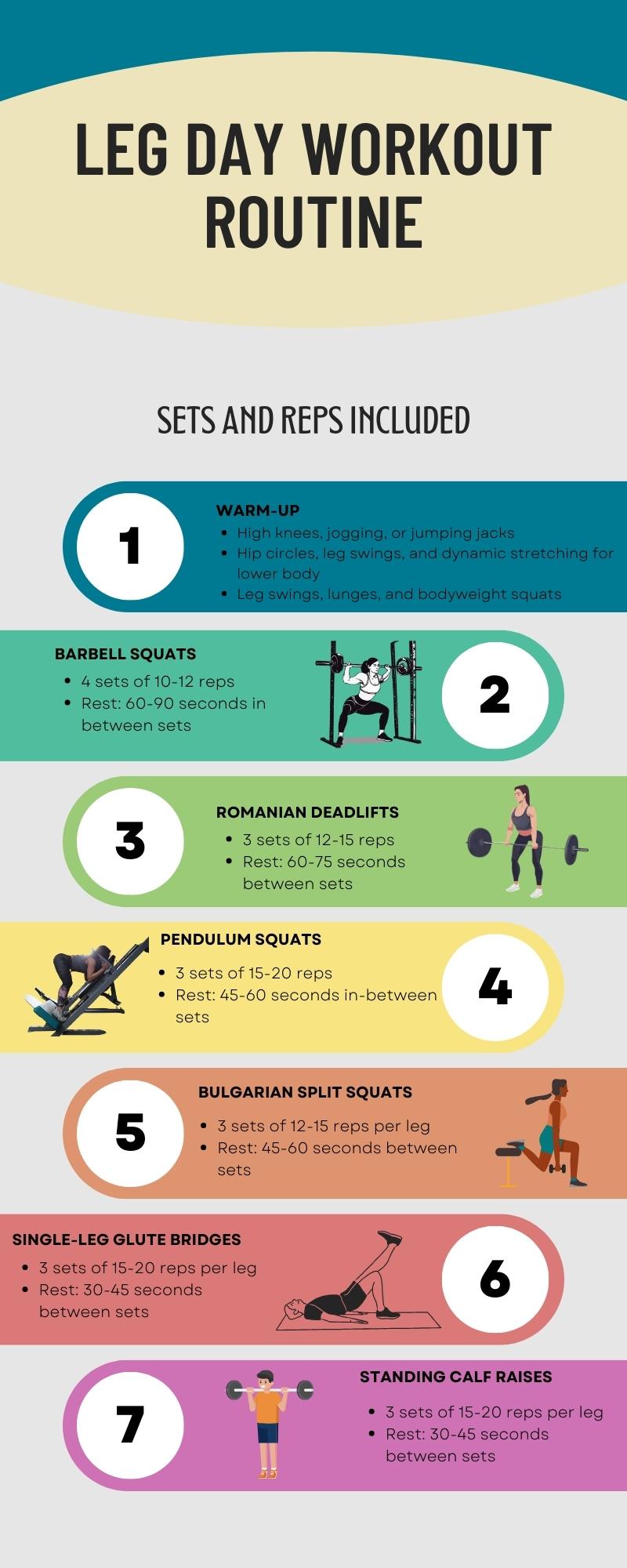
Warm-up:
- Cardiovascular warm-up (5-10 minutes): High knees, jogging, or jumping jacks.
- Dynamic stretching (5 minutes): Hip circles, leg swings, and dynamic stretching for lower body
- Activation of muscles (5 minutes): Leg swings, lunges, and bodyweight squats to activate all the major leg muscle groups
Workout:
Barbell squats:
- 4 sets of 10-12 reps
- Rest: 60-90 seconds in between sets
- Keep your chest up, push through your heels, and maintain a proper form
Romanian deadlifts:
- 3 sets of 12-15 reps
- Rest: 60-75 seconds between sets
- Keep the back straight, maintain a slight bend in the knees, and hinge at the hips when doing a Romanian deadlift.
Pendulum squats:
- 3 sets of 15-20 reps
- Rest: 45-60 seconds in-between sets
- Focus on a controlled movement, and you can use a Smith or cable machine for variations
Bulgarian split squats (dumbbell or barbell):
- 3 sets of 12-15 reps per leg
- Rest: 45-60 seconds between sets
- Hold the dumbbells shoulder-width apart, maintain a proper balance, and use a bench for elevation.
Single-leg glute bridges:
- 3 sets of 15-20 reps per leg
- Rest: 30-45 seconds between sets
- To maximize the activation, squeeze the glutes with every movement.
Standing calf raises:
- 4 sets of 15-20 reps
- Rest: 30-45 seconds between sets
- Use a calf raise machine or an elevated surface.
How Should I Warm-up Before My Leg Workout?
You should warm up before your leg workout by doing 5-10 minutes of light activities like jumping jacks or jogging to prepare your muscles and activate them for a workout.
Doing a proper warm-up will help increase your heart rate and get your blood pumping. Then, do some dynamic stretching for your knees, for example, high knees or leg swings, to loosen up your joints and improve flexibility in general.
To activate the muscle you intend to use in a workout, do some simple movements like lunges or bodyweight squats. After some time, gradually increase the intensity to prepare yourself for real work.
What Are the Benefits of Training Your Legs?
The benefits of training your legs are increased muscle mass and increased strength. In addition, enhanced metabolism and improved athletic performance are also worth mentioning.
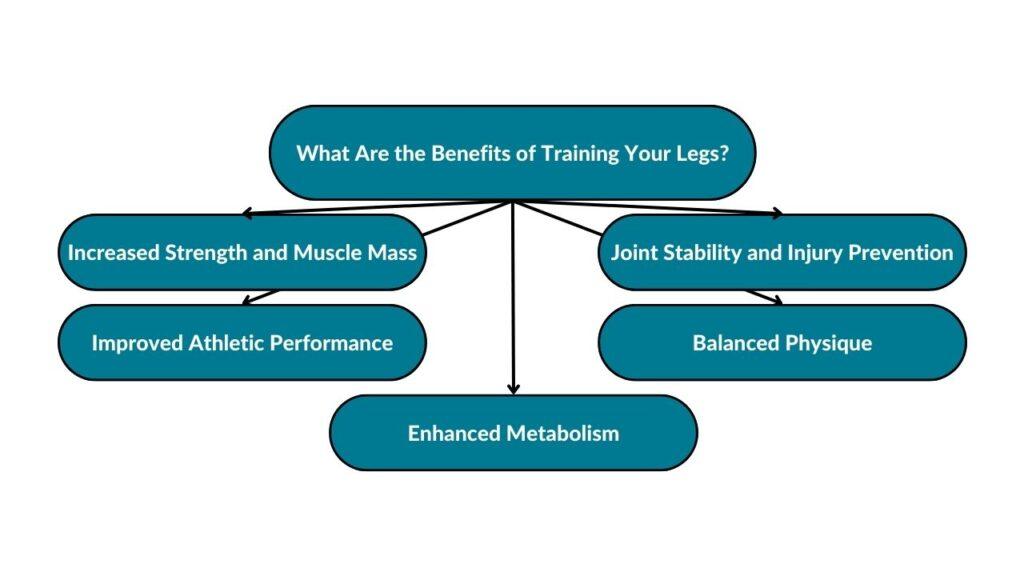
To get the full list of benefits of training your legs, read below for some additional benefits.
Increased Strength and Muscle Mass
Having leg training is extremely beneficial for improving your overall strength and gaining muscle mass [1]. A compound leg exercise like a deadlift or a squat will engage several muscle groups at once, stimulating significant muscle growth.
Since it is the largest muscle group in your whole body, strengthening the leg muscle will help tremendously with overall strength. Basic leg training using progressive overload will ensure you have muscle hypertrophy, giving you a foundation for improved functional strength.
Improved Athletic Performance
A strong, well-conditioned leg muscle is essential for your athletic abilities. Leg day exercises are great at enhancing your speed, power, agility, and other critical elements in all sports. Improving muscular endurance in your lower body will translate into better performance in activities like jumping, running, or even a sudden change of direction.
If you are an athlete, going through leg exercises will improve your strength and explosiveness, making you perform better and giving you a competitive edge in your sport.
Enhanced Metabolism
A leg day workout contributes significantly to the enhancement of your metabolism. Doing weight training, especially leg training, requires a substantial amount of energy expenditure when you are practicing, as well as during the recovery process.
With this, you get more calories burned, meaning not only will you lose body fat but also improve your overall metabolism efficiency. In addition, when you train legs, it stimulates the release of testosterone and growth hormones, which further support metabolic functions and increase energy levels.
Balanced Physique
Having a well-rounded training philosophy means you have all of the muscle groups proportionate, and having chicken legs will cause your look to be imbalanced. Doing leg training will contribute to the perfect physique, giving you body symmetry between the upper body and lower body.
To get to the point of having a balanced physique, training all the major muscle groups is essential. Doing regular leg workouts can give you a strong base, making sure that none of the muscles are overlooked in the pursuit of a visually appealing appearance.
Joint Stability and Injury Prevention
Having proper leg training will foster joint stability and reinforce the connective tissue around the ankles, knees, and hips. Improving the strength of the muscles that surround these joints will give you support and stability, reducing the chance of an injury [2].
As individuals age, it is important to maintain their joint health and prevent any damage. Some of the leg exercises will strengthen your hamstrings, glutes, and quads, contributing to joint stability, improving your functional movement, and decreasing the chance of any sprains.
To prevent lower body injuries, implementing leg training on a regular basis will serve as prevention.
What Muscles Make Up the Legs?
Hamstrings, quads, abductors, calves, and glutes make up the legs. However, it is important to mention that all of these muscle groups are each made up of smaller muscles.
The majority of muscles in the leg are thought of as long muscles that stretch great distances. When these muscles contract and relax, they move skeletal bones to create movement in the body.
Smaller muscles help the bigger muscles, help rotate joints, stabilize joints, and stimulate other movements. Knowing about these muscles is as if you would have a map of your legs, helping you understand their construction and how to keep them strong and flexible.
FAQs
What Is a Perfect Leg Workout?
A perfect leg workout will work all of the leg muscles. If there is one movement that you must do, squats are the superior movement.
Is 5 Exercises Enough for Legs?
Yes, 5 exercises for legs are enough. Make sure that you are training your legs for fatigue, not failure.
What Is the Best Day to Workout Legs?
The best day to work out your legs is Monday or Tuesday. This allows you to have a recovery time as the week progresses, as the leg workout is often the hardest and most intense and requires more recovery in comparison to other muscle groups.
What Is the Best Exercise to Build Your Legs?
The front squat is the best exercise to build your legs. With this exercise, you work almost all of the leg muscles, and it is a great way to build leg strength overall.
How Many Squats per Day?
Start with 2-3 reps of 10-15 squats per day. As you improve and get stronger, you can increase the number of sets and reps.
Why Is Leg Day So Hard?
Leg day is so hard since your legs are much stronger than the rest of your body. Therefore, you can lift much more weight with your lower body than you can with your upper body, which increases overall intensity and central nervous system (CNS) fatigue.
What Builds Legs Fast?
Compound leg exercises like lunges, squats, and deadlifts build legs fast. These are key for building functional strength, getting the heart pumping and burning a lot of calories, and improving your cardiovascular fitness as well as your strength.
How Do I Start Leg Day?
You can start the leg day by doing bodyweight exercises. One of the best bodyweight exercises is, of course, the squat, which will get your lower body prepared.
How Long Should Leg Day Take?
A leg day should take 60 to 90 minutes. It will depend on the amount of exercises you plan to do, as well as the number of sets and reps you do for each exercise.
Should I Train Legs First?
Yes, you should train your legs first. After finishing your leg day routine, it is recommended to do a cardio session for recovery, but not immediately after. You should allow for at least 48 hours between your leg and cardio workout session.
Is There a Better Way to Program My Leg Workouts and Stay More Motivated?
Yes, there is a way to program your leg workouts and stay more motivated. Programming your own workouts can be difficult, and there is always a chance that you will injure yourself.
If you are serious about improving your strength and workout program, feel free to contact me for a brief 1 on 1 call to make you a new workout plan or even improve your existing one.
Start Building Your Dream Body Today
Ready to elevate your fitness game without falling into the trap of dull, repetitive routines that just don’t deliver? Imagine sculpting your ideal physique and boosting your health, all while still enjoying life’s pleasures, like those irresistible weekend getaways and your aunt’s legendary cheesecake. With our online fitness and nutrition coaching service, you don’t have to compromise. Dive into a personalized fitness journey that blends perfectly with your lifestyle, not against it. Book your completely free discovery consultation today, and take the first step towards a transformation that doesn’t require giving up the joys of life.

“I was skeptical about online fitness coaching, but Functional Body Savage completely changed my perspective. Vanja and Radomir’s personalized approach and attention to detail have helped me achieve goals I never thought possible. I’m stronger, more confident, and grateful for their guidance.”
Emily Thompson, San Francisco, CA
Learn More About Our Online Coaching ServiceReferences:
- Krzysztofik M, Wilk M, Wojdała G, Gołaś A. Maximizing Muscle Hypertrophy: A Systematic Review of Advanced Resistance Training Techniques and Methods. Int J Environ Res Public Health. 2019;16(24):4897. Published 2019 Dec 4. doi:10.3390/ijerph16244897
- Huxel Bliven KC, Anderson BE. Core stability training for injury prevention. Sports Health. 2013;5(6):514-522. doi:10.1177/1941738113481200

